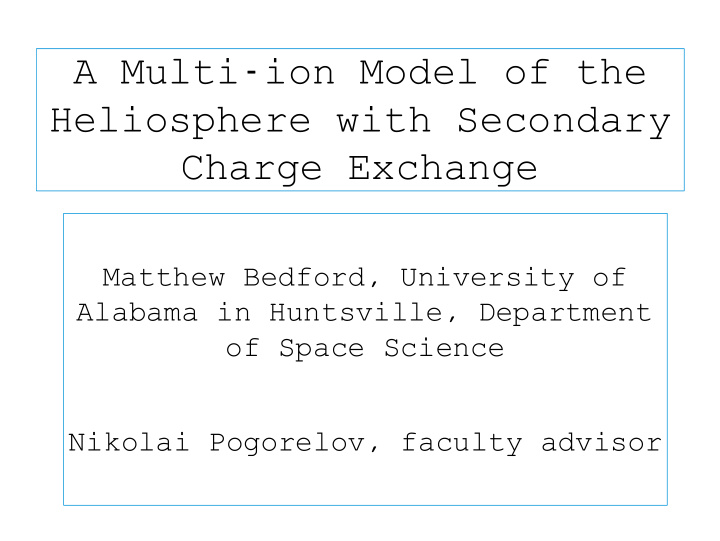



A Multi-ion Model of the Heliosphere with Secondary Charge Exchange Matthew Bedford, University of Alabama in Huntsville, Department of Space Science Nikolai Pogorelov, faculty advisor
The heliosphere ● Solar wind (SW) – (mostly) hydrogen plasma streaming radially outward from Sun, ~400- 800 km/s (supersonic), ~50 000 K ● Local interstellar medium (LISM) – flows uniformly, ~26 km/s (subsonic?), ~8 000 K ● SW and LISM separated by contact discontinuity, the heliopause (HP) ● SW becomes subsonic at termination shock (TS)
Regions of the heliosphere ● LISM plasma flows from the right, around the HP ● Neutral atoms not affected ● SW plasma blown to the left along with LISM ● LISM slows ahead of HP ● Abrupt jump in density at TS
Charge exchange and pickup ions (PUIs) ● Fast SW ion and slow LISM neutral atom exchange electron, yielding fast neutral atom and slow ion (in observer frame) ● New ions gyrate around magnetic field in ring-beam distribution with radius close to the SW streaming velocity ● New ion distribution rapidly isotropized by MHD waves, “picked up” by motional electric field until co-moving with parent 𝐹 = −𝑉 × 𝐶 ions (the “core” SW) ● PUIs do not reach thermal equilibrium with core SW before exiting heliosphere
Motivation – why PUIs? • Voyager 2 measurements show supersonic SW downstream of TS – streaming kinetic energy should become thermal energy but ~80% of energy is unaccounted for • V2 can measure low- energy SW, high-energy cosmic rays, but not PUIs Fast-mode Mach number from Voyager 2 daily averaged data, • Inference: most of the 2007-2015. The green line downstream energy is shows M=1. contained in PUIs (Richardson 2008)
Pickup ions ● PUIs are much hotter, not in equilibrium with core SW - single normal distribution does not make sense ● Can model SW with Kappa distribution to get high-energy tails, but at the cost of fixed ratio of thermal to pickup ions ● Solution: two normal distributions
Physical model ● Multi-fluid magnetohydrodynamic (MHD) model ● One fluid for plasma mixture (thermal and pickup protons), three neutral fluids ● Since PUIs co-move with SW plasma, no need for separate equations for momentum and magnetic field – density and pressure sufficient ● Control fraction of plasma that is nonthermal with boundary conditions at TS ● Source terms for charge exchange, depending on both region and parent particles – can control which chemical reactions result in PUIs
Plasma mixture: Neutrals: Pickup ions:
Source terms • Products of a given charge exchange event depend not only on the parent particles but also the region - each set of products has distinct temperature, density profiles • At least a dozen distinguishable populations possible – too unwieldy for multi-fluid model • Solution: group all “hot” and “cold” plasma products with like products from other events, group all neutrals together which are born in the same region • Separation justified by results of kinetic simulations (Malama et al. 2005)
The first test • In the LISM, allow PUIs to convect without charge exchange • In the super- sonic SW, use the reactions at right • In the helio- sheath, try two ?? ?? possibilities: ?? ?? all reactions result in PUIs, ?? ?? or none
The second test • The model does not solve a complete set of MHD equations for PUIs, just pressure and density • To couple these relations to the mixture equations, an additional boundary condition is needed – apply at the termination shock • Suitable conditions should depend only on mixture quantities and upstream PUI values – since the mixture equations are solved self- consistently, relations may depend on mixture values downstream
Shock boundary conditions • First method – enforce entropy conservation for the thermal component, assuming the same compression ratio: • This assigns • Second method – use Liouville theorem across the shock, assuming strong pitch-angle scattering (Fahr & Chalov 2008): • Then • Third method: integrate kinetic transport equation across shock: • Then
Computation • System solved on 256x96x128 spherical grid, 12-1200 AU exponential R spacing • Grid, parallelization handled by Chombo • Typical run: 512-1024 MPI tasks with 2 OpenMP threads found to be optimal for this problem • Many runs to explore parameter space instead of fewer at higher resolution • Used entire 50k node-hour allocation
Results
Effects of source terms The heliopause expands as expected in the case (left) that charge exchange in the heliosheath results in only PUIs vs. only thermal protons, but the difference is minimal in the nose.
Effects of BCs • PUIs with proper BCs necessary to reproduce • Without PUIs, fast Mach number too low both upstream and downstream • Source terms have less effect than anticipated in the V2 direction
Effects of current sheet Heliospheric current sheet causes unrealistic artifacts. Proper treatment requires time-dependent solar cycle.
References • Fahr, H. J. & Chalov, S. V., Supersonic solar wind ion flows downstream of the termination shock explained by a two-fluid shock model, A&A 490, L35 – L38 (2008) • Malama, Y. G., Izmodenov, V. V., & Chalov, S. V., Modeling of the heliospheric interface: multi-component nature of the heliospheric plasma, A&A 445, 693 – 701 (2006) • Richardson, J. D., Kasper, J. C., Wang, C., Belcher, J. W., & Lazarus, A. J., Cool heliosheath plasma and deceleration of the upstream solar wind at the termination shock, Nature, Volume 454, Issue 7200, pp. 63-66 (2008)
Recommend
More recommend